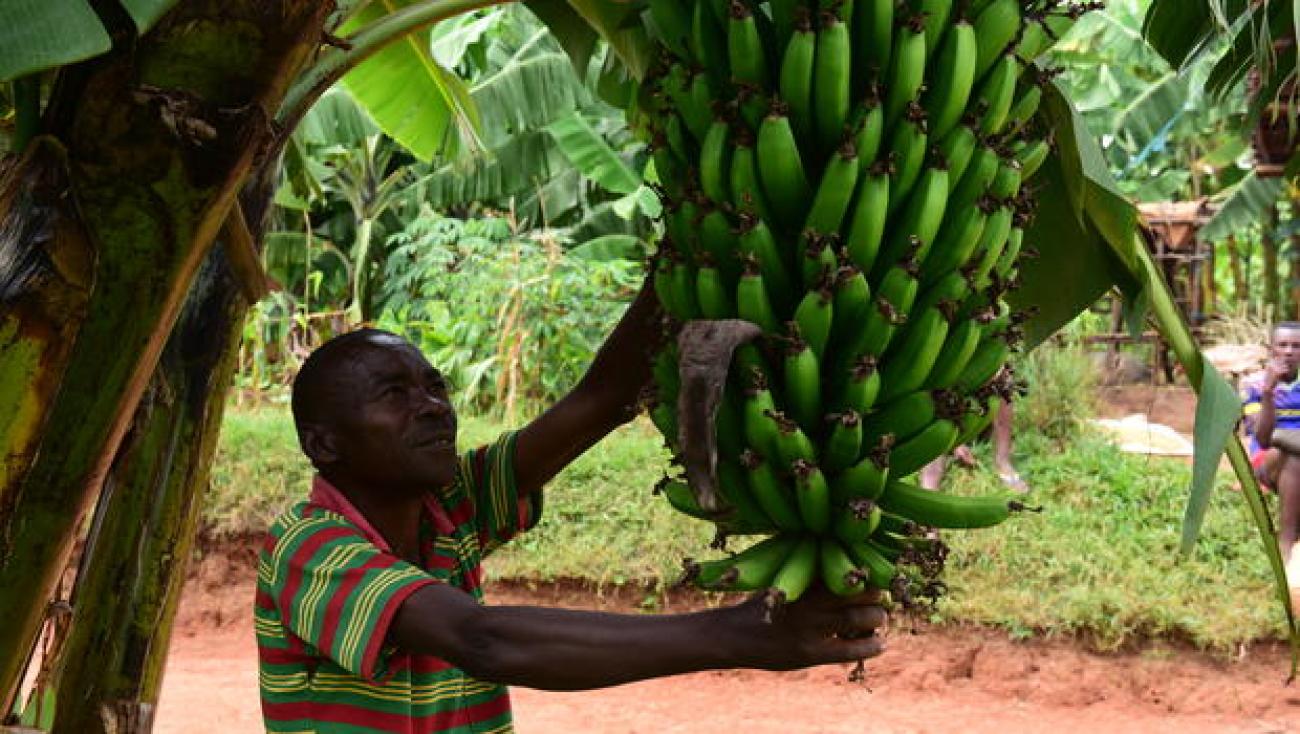Increasing banana production and productivity through clean and high yielding suckers

Fighting pests and diseases in banana takes both training and distribution of clean seedlings
Banana has carried significant importance to Rwanda’s dietary for a long time now. It is one of highly consumed staple crops in the country thanks to its multipurpose uses –culinary and wine brewing.
Currently, there are more than 60 banana varieties in farmers’ fields, and 117 in RAB field collection. The commonly grown varieties being; Injagi, FHIA 17 and FHIA 25, Gros Michel, and Poyo. Others are - Mpologoma, Icyerwa, Poyo, Kamaramasenge, Barabeshya, Nkazikamwa, Intokatoke.
The proportions of banana types are: 45% beer type; 45% cooking type; and 10% dessert type.
Banana production in Rwanda averages at about 2.5 million metric tons per year. The crop is grown on about 165,000 ha and occupy 23% of all arable land in the country (Seasonal Agricultural Survey reports (SAS), NISR).
Rwanda Agriculture and Animal Resources Development Board (RAB) estimates that there are about 1.4 million smallholder banana growers – out of about 8 million people who rely on agriculture in the country – concentrated mainly in five major banana farming districts, namely; Ngoma, Kirehe, Gatsibo, Kayonza and Rwamagana. Their main market is Kigali urban market, although the export base is still growing.
Many farmers especially in rural areas are making big businesses out of the banana trade.
Jean Marie Vianney Mulangira from Nyabisengre sector, Gisagara District grows 1,000 banana trees on 1 hectare. He grows Poyo and Injaji and other varieties. Every season he harvests and earns a profit of RWF 1.5 million (approx. USD 1,700).
“From banana I was able to take my two children to school, built three rental houses and bought more land to expand my farming. I also bought a motorbike that helps me to monitor my activities. Life is good,” says Mulangira.
High demand for banana
An average Rwandan consumes about 227 kilogram per year. Apart from the increasing demand at the household level, demand has also been coming from processing factories.
A few years ago, a number of banana processing plants were established in areas with high concentration and viability of Bananas with the aim of providing a ready market for local banana farmers.
“Cooking banana is under expansion and production is sold as urban demand is stable and increasing,” said Svetlana V. Gaidashova, a Banana researcher at RAB.
Faida Matia, a banana farmer in Mukindo sector, Gisagara District, inspecting his banana for Banana Xanthomonas Wilt. Photo credit: ©FAO/Teopista Mutesi
FAO’s support
Like any other crop, banana cultivation has been faced with the outbreak of pests and diseases such as, Banana Xanthomonas Wilt locally known as Kirabiranya which has affected about 3 600 ha out of 170 000 ha of the total banana area. The symptoms include a gradual wilting and yellowing of the leaves plus wilting of the bracts and contracting of the buds.
The first outbreak of the disease in Rwanda was seen in 2005. The economic losses from Kirabiranya are underestimated because there is production loss from uprooted fields and sick fields thus production goes down and farmers do not earn what they should from banana area. Because of whole banana field uprooting there is also loss of diversity – banana varieties disappear. The spread of the disease could undermine food security in the country and affect the incomes of banana farmers and dealers.
The affected bananas are uprooted, decimated, burned and buried until they rot. For six months or a year, a farmer doesn’t replant banana in the same soil, however, other crops can be planted in that very place where infected bananas were removed.
The primary approach to fight banana diseases and promote banana production has been to plant clean and disease resistant banana planting materials.
To complement the government’s existing efforts to eradicate pests and diseases in the bananas, the Food and Agriculture Organization of the United Nations (FAO), through the project ”Support for enhancing the production and distribution of seeds and banana planting materials” implemented in collaboration with the Ministry of Agriculture and Animal Resources (MINAGRI), distributed high yielding varieties and clean banana planting materials to farmers in five districts (Gisagara, Muhanga, Karongi, Rwamagana and Rubavu).
The project is also providing refresher training to farmers, district, sector agronomists and farmer promoters on proper banana farming techniques.
“Two reasons why I think banana diseases have persisted in our areas is, one, getting seedlings from unreliable sources. The other is poor farming techniques,” explains Pasteur Nsanzimana, a farmer promoter in Rongi sector, Muhanga District.
Murekatete Aline is a second generation banana farmers in Rubavu sector, Rubavu District. She has been fighting the Banana Xanthomonas Wilt for some time now. She received 20 suckers and training on banana farming.
Ambrose Nyarwaya, a father of seven, received 28 FHIA 17 and FHIA 25 banana varieties from the project. When he harvests the banana he plans to buy a bicycle and a cow.
“I have been growing beans, potatoes and maize for home consumption. Since these varieties I was given have high productivity, I intend to sell them and earn income when I harvest,” says Ambrose.
In Gisagara, farmers sell a kilo of banana at RWF100 to the processing factory and RWF120 to the market in the neighboring Huye district.
FHIA banana can weigh between 45 to 80 kg depending on soil nutrients.







